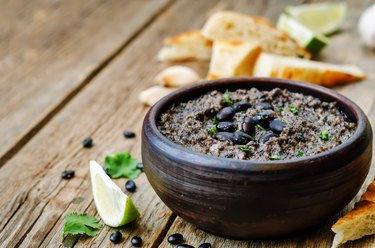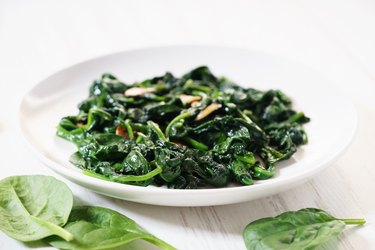Thiamin, aka vitamin B1, is one of the key nutrients required for energy production in the body. In particular, thiamin plays a critical role in pathways that help us extract energy from the foods we eat.
The nutrient is also critical for proper nervous system function and muscle cell contraction, per the U.S. National Library of Medicine (NLM).
Video of the Day
Most of the thiamin that occurs in food is phosphorylated, meaning it is bound to a phosphate molecule. Enzymes in the intestines free the bound thiamin from this molecule so that the vitamin can be absorbed in the body, per the National Institutes of Health (NIH).
How Much Thiamin Do You Need Per Day?
A Recommended Dietary Allowance, or RDA, tells us how much of a nutrient we should eat every day. RDAs determine the average daily intake level that will meet the nutrient needs of most people.
The RDA for thiamin is different for people assigned male at birth (AMAB) and people assigned female at birth (AFAB). People AMAB ages 19 years and older should aim to eat 1.2 milligrams (mg) of thiamin per day. People AFAB ages 19 years and older should aim for 1.1 mg of thiamin per day. Pregnant and lactating people need slightly more vitamin B1, about 1.4 mg per day.
Video of the Day
Certain populations are at greater risk of thiamin deficiency, including people with chronic alcohol use disorders, those with HIV or AIDS, older people, people with diabetes and those who've had bariatric surgery, per the NIH.
Early symptoms of a thiamin deficiency (also called beriberi) can include weakness, weight loss, disorientation and difficulty with memory and peripheral neuropathy. Long-term, it can cause Wernicke-Korsakoff syndrome, which can be life-threatening.
Keep reading for the best vitamin B1 foods to increase your thiamin levels. Note that the Daily Value (DV) percentages featured below are based on an RDA of 1.2 milligrams of thiamin per day.
1. Pork Chops: 96% Daily Value (DV)

A pork chop can provide nearly a day's worth of thiamin, with 1.1 milligrams or 96 percent of the DV in one 6-ounce cooked serving. Round out your chop with green peas and acorn squash, two thiamin-rich vegetarian foods, for a hearty dinner that's sure to satisfy.
2. Salmon: 48% DV
Salmon is one of the best sources of the anti-inflammatory omega-3 fatty acids EPA and DHA. Not to mention, a cooked 6-ounce filet of salmon also serves up 0.6 milligrams or 48 percent of the DV for thiamin, plus an impressive 38 grams of protein.
Don't miss our complete guide to cooking salmon.
3. Whole Grains and Whole-Grain Products: 47% to 30% DV
A nourishing source of energizing carbohydrates, whole grains are some of the best vegetarian sources of thiamin. Add these B1-rich picks to your shopping cart:
4. Flax Seeds: 39% DV
Flax seeds are sky-high in fiber, rich in plant-based omega-3 fats and stocked with thiamin. Just 1 ounce of the super seeds provides 0.5 milligrams or 39 percent of the DV for vitamin B1.
Opt for ground flax seeds, which are easier for the body to digest than whole flax seeds. Stir them into your yogurt or oatmeal bowl, or mix them into a muffin recipe for a no-brainer nutritional boost.
5. Beans: 36% DV

Most beans are high in thiamin:
Beans deliver plant-based protein, iron, magnesium and about 15 grams of fiber per cup. That's pretty darn good considering most Americans get only 15 grams of fiber per day, according to the University of California San Francisco Health. Don't sleep on these surprisingly delicious bean recipes.
6. Green Peas: 36% DV
Small but mighty, green peas are another food rich in thiamin. A 1-cup serving of cooked green peas delivers 0.4 milligrams or 36 percent of the DV for the nutrient, along with iron, potassium and vitamins A and K.
7. Sunflower Seeds: 35% DV
One of the richest dietary sources of the antioxidant vitamin E, sunflower seeds don't skimp on niacin either. Just 1 ounce of roasted sunflower seeds supplies 0.4 milligrams or 35 percent of the DV for vitamin B1.
Choose unsalted sunflower seeds if you're trying to eat less sodium.
8. Firm Tofu: 33% DV
Soy is one of the only plants that counts as a complete protein, meaning it contains all nine of the essential amino acids that the body can't produce on its own. A 1-cup serving of raw tofu also provides 0.4 milligrams or 33 percent of the DV for thiamin.
Try the protein in these anything-but-boring tofu recipes.
9. Acorn Squash: 29% DV
One cup of cooked acorn squash contains 0.3 milligrams or 29 percent of the DV for thiamin, not to mention 9 grams of fiber and 25 percent of the DV for vitamin C. Try this vegan stuffed acorn squash recipe for your next healthy, meat-free meal.
10. Fortified Breakfast Cereal: 28% DV
One cup of fortified corn flakes has 0.3 milligrams or 28 percent DV of thiamin. Always check the back of your cereal box to make sure it's fortified with vitamins and minerals, and opt for whole-grain cereals when you can to get more fiber and protein.
11. Lentils: 28% DV

A nutrient-dense source of plant protein and fiber, the pulses provide essential nutrients like folate, manganese, iron and potassium, per the Harvard T.H. Chan School of Public Health.
Just 1 cup of cooked lentils also brings 0.3 milligrams or 28 percent of the DV for thiamin to the table. Try these cozy lentil recipes that pack just as much protein as chicken.
12. Macadamia Nuts: 28% DV
A 1-ounce serving of macadamia nuts — or about 10 to 12 kernels — contains 0.3 milligrams or 28 percent of the DV for vitamin B1. Mix the crunchy nuts into a DIY trail mix for a heart-healthy and energizing snack.
13. Asparagus: 24% DV
If you're looking to get rid of bloat, opt for asparagus. The green spears contain a compound called asparagine that acts as a natural diuretic, per the NLM. In other words, it may help reduce water retention.
Also nice: A 1-cup serving of cooked asparagus will get you 0.3 milligrams or 24 percent of the DV for thiamin.
14. Mussels: 21% DV
Mussels are a must for those looking to eat more B vitamins. Three ounces of cooked mussels delivers 0.3 milligrams or 21 percent of the DV for thiamin, not to mention 850 percent of the DV for vitamin B12.
15. Pistachios: 21% DV
Go ahead and throw some pistachios in that homemade trail mix, too. A 1-ounce serving of pistachios, or 49 kernels, can provide about 0.2 milligrams or 21 percent of the DV for thiamin.
- National Library of Medicine: “Asparagine”
- Harvard Medical School: “Legume of the Month: Peas”
- University of California San Francisco Health: “Increasing Fiber Intake”
- Environmental Science & Technology: “Declining Mercury Concentrations in Bluefin Tuna Reflect Reduced Emissions to the North Atlantic Ocean”
- World Health Organization: “Cancer: Carcinogenicity of the Consumption of Red Meat and Processed Meat”
- U.S. National Library of Medicine: “Thiamin”
- My Food Data: “Pork Chops (Lean)”
- My Food Data: “Cured Ham”
- My Food Data: “Farmed Atlantic Salmon”
- My Food Data: “Bluefin Tuna (Cooked)”
- My Food Data: “Flax Seeds”
- My Food Data: “Dried Sunflower Seeds”
- My Food Data: “Macadamia Nuts”
- My Food Data: “Pistachio Nuts”
- My Food Data: “Navy Beans”
- My Food Data: “Black Beans”
- My Food Data: “Lentils (Cooked)”
- My Food Data: “Cooked Green Peas”
- My Food Data: “Firm Tofu”
- My Food Data: “Brown Rice”
- My Food Data: “Baked Acorn Squash”
- My Food Data: “Asparagus (Cooked)”
- My Food Data: “Cooked Blue Mussels”
- National Institutes of Health: “Thiamin Fact Sheet for Health Professionals”


